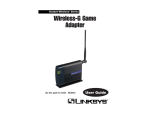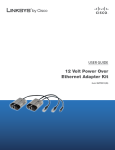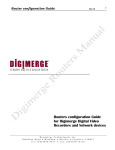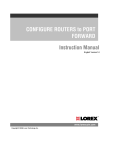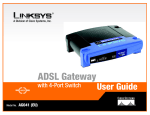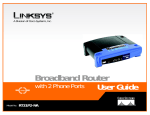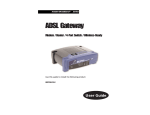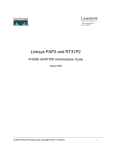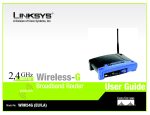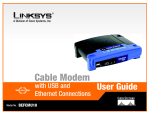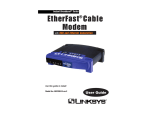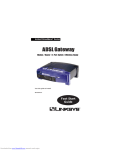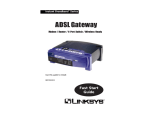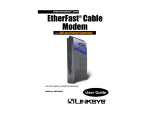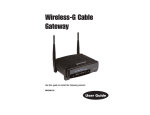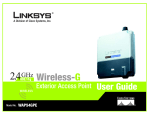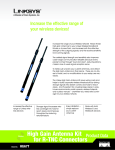Download Linksys 12 Volt Power Over Ethernet Adapter Kit
Transcript
® A Division of Cisco Systems, Inc. 12 Volt Power Over Ethernet Adapter Kit WIRED Model No. WAPPOE12 User Guide 12 Volt Power Over Ethernet Adapter Kit Copyright and Trademarks Specifications are subject to change without notice. Linksys is a registered trademark or trademark of Cisco Systems, Inc. and/or its affiliates in the U.S. and certain other countries. Copyright © 2004 Cisco Systems, Inc. All rights reserved. Other brands and product names are trademarks or registered trademarks of their respective holders. WARNING: This product contains chemicals, including lead, known to the State of California to cause cancer, and birth defects or other reproductive harm. Wash hands after handling. How to Use this Guide Your guide to the 12 Volt Power Over Ethernet Adapter Kit has been designed to make understanding networking with the Power Over Ethernet Adapter Kit easier than ever. Look for the following items when reading this Guide: This exclamation point means there is a caution or warning and is something that could damage your property or Power Over Ethernet Adapter Kit. This question mark provides you with a reminder about something you might need to do while using the Power Over Ethernet Adapter Kit. This checkmark means there is a note of interest and is something you should pay special attention to while using the Power Over Ethernet Adapter Kit. In addition to these symbols, there are definitions for technical terms that are presented like this: Also, each figure (diagram, screenshot, or other image) is provided with a figure number and description, like this: word: definition. Figure numbers and descriptions can also be found in the “List of Figures” section. Figure 0-1: Sample Figure Description WAPPOE12-UG-41105NC JL 12 Volt Power Over Ethernet Adapter Kit Table of Contents Chapter 1: Introduction 1 Welcome What’s in this Guide? 1 3 Chapter 2: Getting to Know the 12 Volt Power Over Ethernet Adapter Kit Overview The Injector The Splitter Chapter 3: Connecting the 12 Volt Power Over Ethernet Adapter Kit Overview Powering on a Device that Uses a Standard Power Adapter Powering on a Device that Uses Inline Power Appendix A: Glossary Appendix B: Specifications Appendix C: Warranty Information Appendix D: Regulatory Information Appendix E: Contact Information 5 5 5 7 9 9 10 12 13 21 23 25 27 12 Volt Power Over Ethernet Adapter Kit List of Figures Figure 2-1: Injector’s First Side Panel Figure 2-2: Injector’s Second Side Panel Figure 2-3: Injector’s LED Figure 2-4: Splitter’s First Side Panel Figure 2-5: Splitter’s Second Side Panel Figure 2-6: Splitter’s LED Figure 3-1: Power Over Ethernet Kit Used with a Switch and Access Point Figure 3-2: Connect the Ethernet Cable to the Injector Figure 3-3: Connect the Ethernet Cable to the Splitter Figure 3-4: Barrel Jack Adapter (optional) Figure 3-5: Connect Power to the Injector Figure 3-6: Connect the Ethernet Cable to the Injector Figure 3-7: Connect Power to the Injector 5 6 6 7 7 8 9 10 10 11 11 12 12 12 Volt Power Over Ethernet Adapter Kit Chapter 1: Introduction Welcome Thank you for choosing the Linksys 12 Volt Power Over Ethernet Adapter Kit. It will let you put your wireless access point or other network device almost anywhere, by eliminating the need for a nearby electrical outlet. The best place for an access point is usually on the ceiling, in the center of the area that needs wireless coverage, and the second best place would be high up on a wall. With the Power Over Ethernet Adapter Kit, you don’t have to run power up to your access point. ethernet: an IEEE standard network protocol that specifies how data is placed on and retrieved from a common transmission medium. poe (power over ethernet): a technology enabling an Ethernet network cable to deliver both data and power. How does the Power Over Ethernet Adapter Kit do this? It delivers power over a Category 5 Ethernet cable. The Power Over Ethernet Adapter Kit includes two devices, the Injector and the Splitter. The Injector sends power and data over the Ethernet cable to the Splitter. Then the Splitter separates the data and power back into two cables access point: a device that allows and delivers them to the remotely located access point—or other network device. The Injector can also be used wireless-equipped computers and other by itself with any Power Over Ethernet (POE)-enabled network device that accept 48 volts directly on a POE port. devices to communicate with a wired network. Also used to expand the range Use the 12 Volt Power Over Ethernet Adapter Kit to send power and data to any Linksys product that requires a of a wireless network. 12-volt power input. (If your Linksys product uses a 5-volt power input, then you should use the 5-volt kit, model number: WAPPOE.) Which Linksys products work with the 12 Volt Power Over Ethernet Adapter Kit? This is a list of the compatible products, alphabetized by model number: • ADSLMUE1 (all versions) - ADSL Modem with USB & Ethernet • AG041 - ADSL Gateway with 4-Port Switch Chapter 1: Introduction Welcome NOTE: This list is subject to change as Linksys introduces new products. 1 12 Volt Power Over Ethernet Adapter Kit • BEFCMU10 (all versions) - Cable Modem with USB and Ethernet Connections • BEFCMUH4 - Cable Gateway • BEFDSR41W - ADSL Gateway • BEFSX41 (versions 1 and 2) - Broadband Firewall Router with 4-Port Switch/VPN Endpoint • BEFW11S4 (version 4) - Wireless-B Broadband Router • RT31P2 - Broadband Router with 2 Phone Ports • WAG54G (versions 1.2 and 2) - Wireless-G ADSL Gateway • WAP54G (version 2) - Wireless-G Access Point • WCG200 (all versions) - Wireless-G Cable Gateway • WGA54G - Wireless-G Game Adapter • WPS54GU2 - Wireless-G PrintServer for USB 2.0 • WRK54G - Wireless-G Broadband Router • WRT54G - Wireless-G Broadband Router • WRT54GS - Wireless-G Broadband Router with SpeedBooster • WRT54GP2 - Wireless-G Broadband Router with 2 Phone Ports Use the instructions in this User Guide to help you connect the Power Over Ethernet Adapter Kit. These instructions should be all you need to get the most out of the Power Over Ethernet Adapter Kit. 2 Chapter 1: Introduction Welcome 12 Volt Power Over Ethernet Adapter Kit What’s in this Guide? This guide covers the steps for installing the Power Over Ethernet Adapter Kit. • Chapter 1: Introduction This chapter describes the Power Over Ethernet Adapter Kit’s application and this User Guide. • Chapter 2: Getting to Know the 12 Volt Power Over Ethernet Adapter Kit This chapter describes the physical features of the Power Over Ethernet Adapter Kit. • Chapter 3: Connecting the 12 Volt Power Over Ethernet Adapter Kit This chapter explains how to connect the Power Over Ethernet Adapter Kit to your network. • Appendix A: Glossary This appendix gives a brief glossary of terms frequently used in networking. • Appendix B: Specifications This appendix provides the technical specifications for the Power Over Ethernet Adapter Kit. • Appendix C: Warranty Information This appendix supplies the warranty information for the Power Over Ethernet Adapter Kit. • Appendix D: Regulatory Information This appendix supplies the regulatory information regarding the Power Over Ethernet Adapter Kit. • Appendix E: Contact Information This appendix provides contact information for a variety of Linksys resources, including Technical Support. Chapter 1: Introduction What’s in this Guide? 3 12 Volt Power Over Ethernet Adapter Kit 4 Chapter 1: Introduction What’s in this Guide? 12 Volt Power Over Ethernet Adapter Kit Chapter 2: Getting to Know the 12 Volt Power Over Ethernet Adapter Kit Overview The Power Over Ethernet Adapter Kit is comprised of two devices, the Injector and Splitter. Use the Kit so you can move your access point, wireless bridge, or other network device to a remote location that is far from an electrical outlet. The Injector The Injector’s built-in cable and ports are located on side panels. The Injector’s First Side Panel The Power & Data OUT port is located on the Injector’s first side panel. Power & Data OUT This port allows you to connect the Injector to the Splitter or a network device that supports inline power. (You will use the included Ethernet network cable to make this connection.) Figure 2-1: Injector’s First Side Panel Chapter 2: Getting to Know the 12 Volt Power Over Ethernet Adapter Kit Overview 5 12 Volt Power Over Ethernet Adapter Kit The Injector’s Second Side Panel The built-in Ethernet network cable and Power port are located on the Injector’s second side panel. Ethernet IN The Injector has a built-in Ethernet network cable. You will connect this cable to one of the Ethernet network ports on your router or switch. Power The Power port is where you will connect the included adapter. The Injector’s LED The Power LED is located on the top of the Injector. Figure 2-2: Injector’s Second Side Panel Figure 2-3: Injector’s LED Power LED 6 Green. The Power LED lights up when the Injector is powered on and ready for use. Chapter 2: Getting to Know the 12 Volt Power Over Ethernet Adapter Kit The Injector 12 Volt Power Over Ethernet Adapter Kit The Splitter The Splitter’s built-in cables and port are located on side panels. The Splitter’s First Side Panel The Power & Data IN port is located on the Injector’s first side panel. Power & Data IN This port allows you to connect the Splitter to the Injector. (You will use the included Ethernet network cable to make this connection.) Figure 2-4: Splitter’s First Side Panel The Splitter’s Second Side Panel The built-in Ethernet network and Power cables are located on the Splitter’s second side panel. Ethernet OUT The Splitter has a built-in Ethernet network cable. You will connect this cable to the Ethernet network port of your remotely located access point or other network device. Power The Splitter has a built-in power cord. You will connect this cord to the Power port of your remotely located access point or other network device. Figure 2-5: Splitter’s Second Side Panel Chapter 2: Getting to Know the 12 Volt Power Over Ethernet Adapter Kit The Splitter 7 12 Volt Power Over Ethernet Adapter Kit The Splitter’s LED The Splitter’s LED is located on the top of the Splitter. Figure 2-6: Splitter’s LED Power LED 8 Green. The Power LED lights up when the Splitter is powered on and ready for use. Chapter 2: Getting to Know the 12 Volt Power Over Ethernet Adapter Kit The Splitter 12 Volt Power Over Ethernet Adapter Kit Chapter 3: Connecting the 12 Volt Power Over Ethernet Adapter Kit Overview This chapter gives instructions on how to connect the Power Over Ethernet Kit. Once connected, the Kit will transmit data and power over the Ethernet network cable to your remotely located network device. The diagram shows an example of how the Kit can be connected to a wired switch and a wireless access point. If you will connect the Kit to a device with a conventional power port, proceed to this section, “Powering on a Device that Uses a Standard Power Adapter.” If you will connect the Kit to a device that supports inline power, proceed to this section, “Powering on a Device that Uses Inline Power.” Figure 3-1: Power Over Ethernet Kit Used with a Switch and Access Point Chapter 3: Connecting the 12 Volt Power Over Ethernet Adapter Kit Overview 9 12 Volt Power Over Ethernet Adapter Kit Powering on a Device that Uses a Standard Power Adapter To use the Power Over Ethernet Kit, follow these instructions: 1. Connect the Injector’s built-in Ethernet network cable to your router, switch, or other network device. 2. Connect the Kit’s included Ethernet network cable to the Injector’s Power & Data OUT port. Then connect the other end to the Splitter’s Power & Data IN port. NOTE: If this cable is not long enough, then you can use your own Ethernet network cable. Figure 3-2: Connect the Ethernet Cable to the Injector Figure 3-3: Connect the Ethernet Cable to the Splitter 10 Chapter 3: Connecting the 12 Volt Power Over Ethernet Adapter Kit Powering on a Device that Uses a Standard Power Adapter 12 Volt Power Over Ethernet Adapter Kit 3. Connect the Splitter’s built-in Ethernet network cable to the Ethernet port of your remotely located access point or other network device. 4. Connect the Splitter’s Power cord to the Power port of your remotely located access point or other network device. NOTE: If the plug of the Splitter’s Power cord does not fit into your network device, then use the included barrel jack adapter. Plug the Splitter’s Power cord into the jack end, and plug the other end of the barrel jack adapter into the Power port of your network device. Figure 3-4: Barrel Jack Adapter (optional) 5. Connect the Kit’s power adapter to the Injector, and plug the other end into an electrical outlet or surge protector. Congratulations! The installation of the Power Over Ethernet Kit is complete. Figure 3-5: Connect Power to the Injector Chapter 3: Connecting the 12 Volt Power Over Ethernet Adapter Kit Powering on a Device that Uses a Standard Power Adapter 11 12 Volt Power Over Ethernet Adapter Kit Powering on a Device that Uses Inline Power You will use only the Injector to power up a device that supports inline power. Follow these instructions: 1. Connect the Injector’s built-in Ethernet network cable to your router, switch, or other network device. 2. Connect the Kit’s included Ethernet network cable to the Injector’s Power & Data OUT port. Then connect the other end to the Ethernet port of your remotely located access point or other network device. NOTE: Your access point or other network device must support inline power on the Ethernet port you are using. 3. Connect the Kit’s power adapter to the Injector, and plug the other end into an electrical outlet or surge protector. Figure 3-6: Connect the Ethernet Cable to the Injector Congratulations! The installation of the Power Over Ethernet Kit is complete. Figure 3-7: Connect Power to the Injector 12 Chapter 3: Connecting the 12 Volt Power Over Ethernet Adapter Kit Powering on a Device that Uses Inline Power 12 Volt Power Over Ethernet Adapter Kit Appendix A: Glossary 802.11a - A wireless networking standard that specifies a maximum data transfer rate of 54Mbps and an operating frequency of 5GHz. 802.11b - A wireless networking standard that specifies a maximum data transfer rate of 11Mbps and an operating frequency of 2.4GHz. 802.11g - A wireless networking standard that specifies a maximum data transfer rate of 54Mbps, an operating frequency of 2.4GHz, and backward compatibility with 802.11b devices. Access Point - A device that allows wireless-equipped computers and other devices to communicate with a wired network. Also used to expand the range of a wireless network. Adapter - A device that adds network functionality to your PC. Ad-hoc - A group of wireless devices communicating directly with each other (peer-to-peer) without the use of an access point. Backbone - The part of a network that connects most of the systems and networks together, and handles the most data. Bandwidth - The transmission capacity of a given device or network. Beacon Interval - Data transmitted on your wireless network that keeps the network synchronized. Bit - A binary digit. Appendix A: Glossary 13 12 Volt Power Over Ethernet Adapter Kit Boot - To start a device and cause it to start executing instructions. Bridge - A device that connects different networks. Broadband - An always-on, fast Internet connection. Browser - An application program that provides a way to look at and interact with all the information on the World Wide Web. Buffer - A shared or assigned memory area that is used to support and coordinate different computing and networking activities so one isn't held up by the other. Byte - A unit of data that is usually eight bits long Cable Modem - A device that connects a computer to the cable television network, which in turn connects to the Internet. CSMA/CA (Carrier Sense Multiple Access/Collision Avoidance) - A method of data transfer that is used to prevent data collisions. CTS (Clear To Send) - A signal sent by a wireless device, signifying that it is ready to receive data. Daisy Chain - A method used to connect devices in a series, one after the other. Database - A collection of data that is organized so that its contents can easily be accessed, managed, and updated. Default Gateway - A device that forwards Internet traffic from your local area network. 14 Appendix A: Glossary 12 Volt Power Over Ethernet Adapter Kit DHCP (Dynamic Host Configuration Protocol) - A networking protocol that allows administrators to assign temporary IP addresses to network computers by “leasing” an IP address to a user for a limited amount of time, instead of assigning permanent IP addresses. DMZ (Demilitarized Zone) - Removes the Router's firewall protection from one PC, allowing it to be “seen” from the Internet. DNS (Domain Name Server) - The IP address of your ISP's server, which translates the names of websites into IP addresses. Domain - A specific name for a network of computers. Download - To receive a file transmitted over a network. DSL (Digital Subscriber Line) - An always-on broadband connection over traditional phone lines. DSSS (Direct-Sequence Spread-Spectrum) - Frequency transmission with a redundant bit pattern resulting in a lower probability of information being lost in transit. DTIM (Delivery Traffic Indication Message) - A message included in data packets that can increase wireless efficiency. Dynamic IP Address - A temporary IP address assigned by a DHCP server. Encryption - Encoding data transmitted in a network. Ethernet - A networking protocol that specifies how data is placed on and retrieved from a common transmission medium. Finger - A program that tells you the name associated with an e-mail address. Appendix A: Glossary 15 12 Volt Power Over Ethernet Adapter Kit Firewall - A set of related programs located at a network gateway server that protects the resources of a network from users from other networks. Firmware - The programming code that runs a networking device. Fragmentation -Breaking a packet into smaller units when transmitting over a network medium that cannot support the original size of the packet. FTP (File Transfer Protocol) - A protocol used to transfer files over a TCP/IP network. Full Duplex - The ability of a networking device to receive and transmit data simultaneously. Gateway - A device that interconnects networks with different, incompatible communications protocols. Half Duplex - Data transmission that can occur in two directions over a single line, but only one direction at a time. Hardware - The physical aspect of computers, telecommunications, and other information technology devices. HTTP (HyperText Transport Protocol) - The communications protocol used to connect to servers on the World Wide Web. Infrastructure - A wireless network that is bridged to a wired network via an access point. IP (Internet Protocol) - A protocol used to send data over a network. IP Address - The address used to identify a computer or device on a network. IPCONFIG - A Windows 2000 and XP utility that displays the IP address for a particular networking device. 16 Appendix A: Glossary 12 Volt Power Over Ethernet Adapter Kit IPSec (Internet Protocol Security) - A VPN protocol used to implement secure exchange of packets at the IP layer. ISM band - Radio bandwidth utilized in wireless transmissions. ISP (Internet Service Provider) - A company that provides access to the Internet. LAN - The computers and networking products that make up your local network. MAC (Media Access Control) Address - The unique address that a manufacturer assigns to each networking device. Mbps (MegaBits Per Second) - One million bits per second; a unit of measurement for data transmission. mIRC - An Internet Relay Chat program that runs under Windows. Multicasting - Sending data to a group of destinations at once. NAT (Network Address Translation) - NAT technology translates IP addresses of a local area network to a different IP address for the Internet. Network - A series of computers or devices connected for the purpose of data sharing, storage, and/or transmission between users. NNTP (Network News Transfer Protocol) - The protocol used to connect to Usenet groups on the Internet. Node - A network junction or connection point, typically a computer or work station. Appendix A: Glossary 17 12 Volt Power Over Ethernet Adapter Kit OFDM (Orthogonal Frequency Division Multiplexing) - Frequency transmission that separates the data stream into a number of lower-speed data streams, which are then transmitted in parallel to prevent information from being lost in transit. Packet - A unit of data sent over a network. Passphrase - Used much like a password, a passphrase simplifies the WEP encryption process by automatically generating the WEP encryption keys for Linksys products. Ping (Packet INternet Groper) - An Internet utility used to determine whether a particular IP address is online. POP3 (Post Office Protocol 3) - A standard mail server commonly used on the Internet. Port - The connection point on a computer or networking device used for plugging in cables or adapters. Power over Ethernet (PoE) - A technology enabling an Ethernet network cable to deliver both data and power. Preamble - Part of the wireless signal that synchronizes network traffic. RJ-45 (Registered Jack-45) - An Ethernet connector that holds up to eight wires. Roaming - The ability to take a wireless device from one access point's range to another without losing the connection. Router - A networking device that connects multiple networks together. RTS (Request To Send) - A networking method of coordinating large packets through the RTS Threshold setting. Server - Any computer whose function in a network is to provide user access to files, printing, communications, and other services. 18 Appendix A: Glossary 12 Volt Power Over Ethernet Adapter Kit SMTP (Simple Mail Transfer Protocol) - The standard e-mail protocol on the Internet. SNMP (Simple Network Management Protocol) - A widely used network monitoring and control protocol. Software - Instructions for the computer. A series of instructions that performs a particular task is called a “program”. SOHO (Small Office/Home Office) - Market segment of professionals who work at home or in small offices. Spread Spectrum - Wideband radio frequency technique used for more reliable and secure data transmission. SSID (Service Set IDentifier) - Your wireless network's name. Static IP Address - A fixed address assigned to a computer or device that is connected to a network. Static Routing - Forwarding data in a network via a fixed path. Subnet Mask - An address code that determines the size of the network. Switch - 1. A data switch that connects computing devices to host computers, allowing a large number of devices to share a limited number of ports. 2. A device for making, breaking, or changing the connections in an electrical circuit. TCP (Transmission Control Protocol) - A network protocol for transmitting data that requires acknowledgement from the recipient of data sent. TCP/IP (Transmission Control Protocol/Internet Protocol) - A set of instructions PCs use to communicate over a network. Telnet - A user command and TCP/IP protocol used for accessing remote PCs. Appendix A: Glossary 19 12 Volt Power Over Ethernet Adapter Kit TFTP (Trivial File Transfer Protocol) - A version of the TCP/IP FTP protocol that has no directory or password capability. Throughput - The amount of data moved successfully from one node to another in a given time period. Topology - The physical layout of a network. TX Rate - Transmission Rate. UDP (User Datagram Protocol) - A network protocol for transmitting data that does not require acknowledgement from the recipient of the data that is sent. Upgrade - To replace existing software or firmware with a newer version. Upload - To transmit a file over a network. URL (Uniform Resource Locator) - The address of a file located on the Internet. VPN (Virtual Private Network) - A security measure to protect data as it leaves one network and goes to another over the Internet. WAN (Wide Area Network)- The Internet. WINIPCFG - A Windows 98 and Me utility that displays the IP address for a particular networking device. WLAN (Wireless Local Area Network) - A group of computers and associated devices that communicate with each other wirelessly. 20 Appendix A: Glossary 12 Volt Power Over Ethernet Adapter Kit Appendix B: Specifications Model WAPPOE12 Standards IEEE 802.3, 802.3u, 802.3af Ports Injector: Power, Data and Power OUT Splitter: Data and Power IN Cabling Type Category 5 or better LED Power Dimensions (W x H x D) 3.15" x 0.87" x 2.20" (80 mm x 22 mm x 56 mm) Unit Weight 2.65 oz. (0.075 kg) Power External Adapter: 100~240VAC, Injector 48VDC Certifications FCC Class B Operating Temp. 32°F to 104°F (0°C to 40°C) Storage Temp. -4°F to 158°F (-20°C to 70°C) Appendix B: Specifications 21 12 Volt Power Over Ethernet Adapter Kit Operating Humidity 10% to 85%, Non-Condensing Storage Humidity 5% to 90%, Non-Condensing 22 Appendix B: Specifications 12 Volt Power Over Ethernet Adapter Kit Appendix C: Warranty Information LIMITED WARRANTY Linksys warrants to You that, for a period of one year (the “Warranty Period”), your Linksys Product will be substantially free of defects in materials and workmanship under normal use. Your exclusive remedy and Linksys' entire liability under this warranty will be for Linksys at its option to repair or replace the Product or refund Your purchase price less any rebates. This limited warranty extends only to the original purchaser. If the Product proves defective during the Warranty Period call Linksys Technical Support in order to obtain a Return Authorization Number, if applicable. BE SURE TO HAVE YOUR PROOF OF PURCHASE ON HAND WHEN CALLING. If You are requested to return the Product, mark the Return Authorization Number clearly on the outside of the package and include a copy of your original proof of purchase. RETURN REQUESTS CANNOT BE PROCESSED WITHOUT PROOF OF PURCHASE. You are responsible for shipping defective Products to Linksys. Linksys pays for UPS Ground shipping from Linksys back to You only. Customers located outside of the United States of America and Canada are responsible for all shipping and handling charges. ALL IMPLIED WARRANTIES AND CONDITIONS OF MERCHANTABILITY OR FITNESS FOR A PARTICULAR PURPOSE ARE LIMITED TO THE DURATION OF THE WARRANTY PERIOD. ALL OTHER EXPRESS OR IMPLIED CONDITIONS, REPRESENTATIONS AND WARRANTIES, INCLUDING ANY IMPLIED WARRANTY OF NONINFRINGEMENT, ARE DISCLAIMED. Some jurisdictions do not allow limitations on how long an implied warranty lasts, so the above limitation may not apply to You. This warranty gives You specific legal rights, and You may also have other rights which vary by jurisdiction. This warranty does not apply if the Product (a) has been altered, except by Linksys, (b) has not been installed, operated, repaired, or maintained in accordance with instructions supplied by Linksys, or (c) has been subjected to abnormal physical or electrical stress, misuse, negligence, or accident. In addition, due to the continual development of new techniques for intruding upon and attacking networks, Linksys does not warrant that the Product will be free of vulnerability to intrusion or attack. TO THE EXTENT NOT PROHIBITED BY LAW, IN NO EVENT WILL LINKSYS BE LIABLE FOR ANY LOST DATA, REVENUE OR PROFIT, OR FOR SPECIAL, INDIRECT, CONSEQUENTIAL, INCIDENTAL OR PUNITIVE DAMAGES, REGARDLESS OF THE THEORY OF LIABILITY (INCLUDING NEGLIGENCE), ARISING OUT OF OR RELATED TO THE USE OF OR INABILITY TO USE THE PRODUCT (INCLUDING ANY SOFTWARE), EVEN IF LINKSYS HAS BEEN ADVISED OF THE POSSIBILITY OF SUCH DAMAGES. Appendix C: Warranty Information 23 12 Volt Power Over Ethernet Adapter Kit IN NO EVENT WILL LINKSYS’ LIABILITY EXCEED THE AMOUNT PAID BY YOU FOR THE PRODUCT. The foregoing limitations will apply even if any warranty or remedy provided under this Agreement fails of its essential purpose. Some jurisdictions do not allow the exclusion or limitation of incidental or consequential damages, so the above limitation or exclusion may not apply to You. Please direct all inquiries to: Linksys, P.O. Box 18558, Irvine, CA 92623. 24 Appendix C: Warranty Information 12 Volt Power Over Ethernet Adapter Kit Appendix D: Regulatory Information FCC STATEMENT This product has been tested and complies with the specifications for a Class B digital device, pursuant to Part 15 of the FCC Rules. These limits are designed to provide reasonable protection against harmful interference in a residential installation. This equipment generates, uses, and can radiate radio frequency energy and, if not installed and used according to the instructions, may cause harmful interference to radio communications. However, there is no guarantee that interference will not occur in a particular installation. If this equipment does cause harmful interference to radio or television reception, which is found by turning the equipment off and on, the user is encouraged to try to correct the interference by one or more of the following measures: • • • • Reorient or relocate the receiving antenna Increase the separation between the equipment or devices Connect the equipment to an outlet other than the receiver's Consult a dealer or an experienced radio/TV technician for assistance INDUSTRY CANADA (CANADA) This Class B digital apparatus complies with Canadian ICES-003. Cet appareil numérique de la classe B est conforme à la norme NMB-003 du Canada. Appendix D: Regulatory Information 25 12 Volt Power Over Ethernet Adapter Kit EC DECLARATION OF CONFORMITY (EUROPE) In compliance with the EMC Directive 89/336/EEC, Low Voltage Directive 73/23/EEC, and Amendment Directive 93/68/EEC, this product meets the requirements of the following standards: • EN55022 Emission • EN55024 Immunity SAFETY NOTICES Caution: To reduce the risk of fire, use only No.26 AWG or larger telecommunication line cord. Do not use this product near water, for example, in a wet basement or near a swimming pool. Avoid using this product during an electrical storm. There may be a remote risk of electric shock from lightning. 26 Appendix D: Regulatory Information 12 Volt Power Over Ethernet Adapter Kit Appendix E: Contact Information Need to contact Linksys? Visit us online for information on the latest products and updates to your existing products at: http://www.linksys.com or ftp.linksys.com Can't find information about a product you want to buy on the web? Do you want to know more about networking with Linksys products? Give our advice line a call at: Or fax your request in to: 800-546-5797 (LINKSYS) 949-823-3002 If you experience problems with any Linksys product, you can call us at: Don't wish to call? You can e-mail us at: 800-326-7114 [email protected] If any Linksys product proves defective during its warranty period, you can call the Linksys Return Merchandise Authorization department for obtaining a Return Authorization Number at: (Details on Warranty and RMA issues can be found in the Warranty Information section in this Guide.) Appendix E: Contact Information 949-823-3000 27 12 Volt Power Over Ethernet Adapter Kit 28 Appendix E: Contact Information www.linksys.com

































